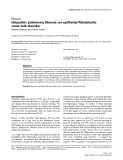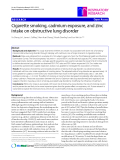
Respiratory disorders
-
This research project aimed to: (a) determine the demographic profile and common conditions of patients in a Teaching Clinic; (b) describe the adverse events from Chinese medicine treatment; (c) examine the overall treatment outcomes and treatment interventions of Chinese medicine in patients with respiratory disorders; and (d) assess the level of knowledge and compliance with Chinese medicine in patients with respiratory disorders.
 304p
304p  runthenight07
runthenight07
 01-03-2023
01-03-2023
 14
14
 3
3
 Download
Download
-
Tuyển tập các báo cáo nghiên cứu về y học được đăng trên tạp chí y học 'Respiratory Research cung cấp cho các bạn kiến thức về ngành y đề tài: "Idiopathic pulmonary fibrosis: an epithelial/fibroblastic cross-talk disorder...
 8p
8p  toshiba13
toshiba13
 22-10-2011
22-10-2011
 48
48
 4
4
 Download
Download
-
Tuyển tập các báo cáo nghiên cứu về y học được đăng trên tạp chí y học 'Respiratory Research cung cấp cho các bạn kiến thức về ngành y đề tài: "Cigarette smoking, cadmium exposure, and zinc intake on obstructive lung disorder...
 8p
8p  toshiba11
toshiba11
 19-10-2011
19-10-2011
 48
48
 5
5
 Download
Download
-
Có 5 loại : 1. Nhiễm toan chuyển hóa (metabolic acidosis) (ví dụ ngừng tim). 2. Nhiễm toan hô hấp (respiratory acidosis) (ví dụ bệnh phổi tắc mãn tính với ứ đọng CO2). 3. Nhiễm kiềm chuyển hóa (metabolic alkolosis) (ví dụ mửa kéo dài) 4. Nhiễm kiềm hô hấp (respiratory acidosis) (ví dụ hội chứng tăng thông khí). 5. Rối loạn axít-kiềm hỗn hợp (nghĩa là nhiễm kiềm hô hấp và nhiễm toan chuyển hóa, như được thấy nơi một người trưởng thành với ngộ độc salicylate ; nhiễm toan chuyển hóa với bù hô hấp). ...
 16p
16p  thiuyen111
thiuyen111
 11-04-2011
11-04-2011
 85
85
 9
9
 Download
Download
CHỦ ĐỀ BẠN MUỐN TÌM
















